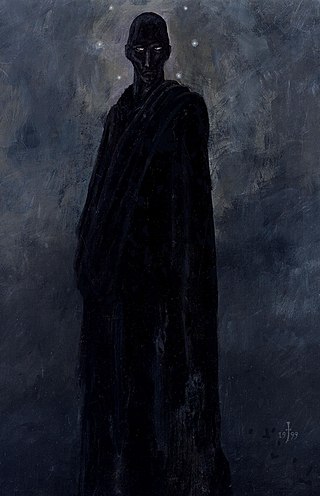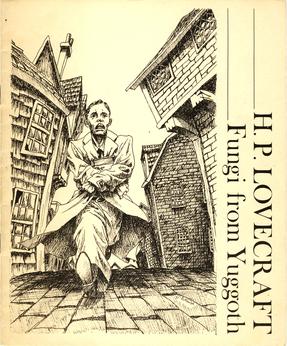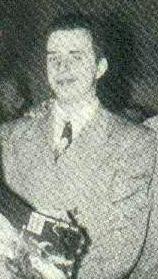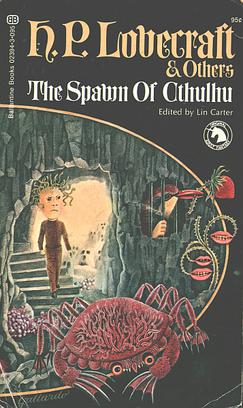
Cold Print is a collection of Lovecraftian horror stories by British writer Ramsey Campbell, first published in 1985 by Scream/Press, reprinted in 1987 by Tor Books, and reissued in an expanded edition in 1993 by Headline.

Cold Print is a collection of Lovecraftian horror stories by British writer Ramsey Campbell, first published in 1985 by Scream/Press, reprinted in 1987 by Tor Books, and reissued in an expanded edition in 1993 by Headline.
The original release of Cold Print contains all but three of the stories from Campbell's first collection, The Inhabitant of the Lake and Less Welcome Tenants (missing are "The Plain of Sound", "The Return of the Witch", and "The Mine on Yuggoth"). Also included are two stories ("The Church in High Street" and "The Stone on the Island"), which first appeared in anthologies edited by August Derleth, as well as later material written explicitly in the Lovecraft vein. "Among the pictures are these:" is not a narrative story but a description of numerous sketches made by the author.
The book is dedicated to Fritz Leiber and Robert Bloch, and contains two introductory pieces by the author, "Lovecraft: An Introduction" (1990) and "Chasing the Unknown" (1985).
The book contains the following stories: [1]
In addition, the expanded edition contains:
Dave Langford reviewed Cold Print for White Dwarf #93, and stated that "In this last tale, a complete abandonment of the standard, all too spoofable Mythos props brings Campbell full circle to the interesting part of Lovecraft's incoherent vision: a universe of vast uncaring entities who may happen to wither our minds, but like editors are fundamentally uninterested in us." [2]

Fritz Reuter Leiber Jr. was an American writer of fantasy, horror, and science fiction. He was also a poet, actor in theater and films, playwright, and chess expert. With writers such as Robert E. Howard and Michael Moorcock, Leiber is one of the fathers of sword and sorcery and coined the term.

Shub-Niggurath is a deity created by H. P. Lovecraft. She is often associated with the phrase "The Black Goat of the Woods with a Thousand Young". The only other name by which Lovecraft referred to her was "Lord of the Wood" in his story The Whisperer in Darkness.

Nyarlathotep is a fictional character created by H. P. Lovecraft. The character is a malign deity in the Cthulhu Mythos, a shared universe. First appearing in Lovecraft's 1920 prose poem "Nyarlathotep", he was later mentioned in other works by Lovecraft and by other writers. Later writers describe him as one of the Outer Gods, an alien pantheon.

Ramsey Campbell is an English horror fiction writer, editor and critic who has been writing for well over fifty years. He is the author of over 30 novels and hundreds of short stories, many of them winners of literary awards. Three of his novels have been adapted into films.
Arkham House was an American publishing house specializing in weird fiction. It was founded in Sauk City, Wisconsin, in 1939 by August Derleth and Donald Wandrei to publish hardcover collections of H. P. Lovecraft's best works, which had previously been published only in pulp magazines. The company's name is derived from Lovecraft's fictional New England city, Arkham, Massachusetts. Arkham House editions are noted for the quality of their printing and binding. The colophon for Arkham House was designed by Frank Utpatel.

Azathoth is a deity in the Cthulhu Mythos and Dream Cycle stories of writer H. P. Lovecraft and other authors. He is the ruler of the Outer Gods, and may be seen as a symbol for primordial chaos.

Fungi from Yuggoth is a sequence of 36 sonnets by cosmic horror writer H. P. Lovecraft. Most of the sonnets were written between 27 December 1929 – 4 January 1930; thereafter individual sonnets appeared in Weird Tales and other genre magazines. The sequence was published complete in Beyond the Wall of Sleep and The Ancient Track: The Complete Poetical Works of H. P. Lovecraft. Ballantine Books’ mass paperback edition, Fungi From Yuggoth & Other Poems included other poetic works.

"The Haunter of the Dark" is a horror short story by American author H. P. Lovecraft, written between 5–9 November 1935 and published in the December 1936 edition of Weird Tales. It was the last written of the author's known works, and is part of the Cthulhu Mythos. The epigraph to the story is the second stanza of Lovecraft's 1917 poem "Nemesis".

Lovecraftian horror, sometimes used interchangeably with "cosmic horror", is a subgenre of horror fiction and weird fiction that emphasizes the horror of the unknowable and incomprehensible more than gore or other elements of shock. It is named after American author H. P. Lovecraft (1890–1937). His work emphasizes themes of cosmic dread, forbidden and dangerous knowledge, madness, non-human influences on humanity, religion and superstition, fate and inevitability, and the risks associated with scientific discoveries, which are now associated with Lovecraftian horror as a subgenre. The cosmic themes of Lovecraftian horror can also be found in other media, notably horror films, horror games, and comics.
Whispers was one of the new horror and fantasy fiction magazines of the 1970s.

The Whisperer in Darkness is a 26,000-word novella by American writer H. P. Lovecraft. Written February–September 1930, it was first published in Weird Tales, August 1931. Similar to The Colour Out of Space (1927), it is a blend of horror and science fiction. Although it makes numerous references to the Cthulhu Mythos, the story is not a central part of the mythos, but reflects a shift in Lovecraft's writing at this time towards science fiction. The story also introduces the Mi-Go, an extraterrestrial race of fungoid creatures.

Robert Augustine Ward "Doc" Lowndes was an American science fiction author, editor and fan. He was known best as the editor of Future Science Fiction, Science Fiction, and Science Fiction Quarterly, among many other crime-fiction, western, sports-fiction, and other pulp and digest sized magazines for Columbia Publications. Among the most famous writers he was first to publish at Columbia was mystery writer Edward D. Hoch, who in turn would contribute to Lowndes's fiction magazines as long as he was editing them. Lowndes was a principal member of the Futurians. His first story, "The Outpost at Altark" for Super Science in 1940, was written in collaboration with fellow Futurian Donald A. Wollheim, uncredited.
A Cthulhu Mythos anthology is a type of short story collection that contains stories written in, or related to, the Cthulhu Mythos genre of horror fiction launched by H. P. Lovecraft. Such anthologies have helped to define and popularize the genre.
Necronomicon Press is an American small press publishing house specializing in fiction, poetry and literary criticism relating to the horror and fantasy genres. It is run by Marc A. Michaud.

The Inhabitant of the Lake and Less Welcome Tenants is a collection of fantasy and horror short stories by British author J. Ramsey Campbell, who dropped the initial from his name in subsequent publications. It was released in 1964 by Arkham House in an edition of 2,009 copies and was the author's first book. The stories are part of the Cthulhu Mythos. Campbell had originally written his introduction to be included in the book The Dark Brotherhood and Other Pieces under the title "Cthulhu in Britain". However, Arkham's editor, August Derleth, decided to use it here.

Dreams from R'lyeh is a collection of poems by Lin Carter. The book was released in hardcover by Arkham House in 1975 in an edition of 3,152 copies. It was Carter's only book published by Arkham House. The title sequence of sonnets, "Dreams from R'lyeh", has also been reprinted in Robert M. Price's The Xothic Legend Cycle: The Complete Mythos Fiction of Lin Carter.
Richard Louis Tierney was an American writer, poet and scholar of H. P. Lovecraft, probably best known for his heroic fantasy, including his series co-authored of Red Sonja novels, featuring cover art by Boris Vallejo. He lived the latter part of his life in Mason City in the great Corn Steppes of Iowa. Some of his standalone novels utilize the mythology of Lovecraft's Cthulhu Mythos. He is also known for his Simon of Gitta series and his Robert E. Howard completions and utilisation of such Howard-invented characters as Cormac Mac Art, Bran Mak Morn and Cormac Fitzgeoffrey.

The Spawn of Cthulhu is an anthology of fantasy short stories, edited by American writer Lin Carter. It was first published in paperback by Ballantine Books in October 1971 as the thirty-sixth volume of its Ballantine Adult Fantasy series. It was the fifth anthology assembled by Carter for the series.
"The Book" is an unfinished short story by American horror fiction writer H. P. Lovecraft, believed to have been written in late 1933. It was first published in the journal Leaves in 1938, after Lovecraft's death.
The Hungry Moon is a novel by Ramsey Campbell published in 1986.